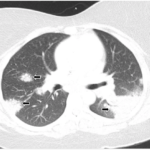
Rido/shutterstock.com
Settling into room 501 at Maine Medical Center, Mrs. N was on her way to the bathroom when she felt it coming on. One moment she was okay; the next, her chest felt damp and cold, even as her face flushed and her temperature spiked. Her forehead glistened beads of warm sweat. She felt the drops coalesce and roll down her cheeks and reached out to steady herself. Swaying, she half-closed her eyes and waited for the “spell” to pass. Then the shivering worsened into an uncontrollable rigor, and she shook from head to toe as if possessed. She wanted to sit, but her feet seemed stuck to the floor. Her husband stood helplessly at her side, a hand over her shoulder, the other in the crook of her elbow.
That’s when I walked in, and for the sixth time—or was it the seventh?—I had absolutely no idea what was wrong.
“Should we get blood cultures?” the medicine resident whispered in my ear.
“Sure. Call lab, and have them grab a STAT set of blood cultures,” I replied. But I knew nothing would grow out on the blood cultures. Nothing had in the past. We’ve gone through this before.
Mrs. N is an FUO—medical parlance for a fever of unknown origin—and by definition, if her disease could be diagnosed by something as simple as a set of blood cultures we wouldn’t be here five months after the onset of her illness, still searching for a diagnosis.
History
The first time I saw Mrs. N in the office the previous spring, her illness had not yet reached full expression. As I watched my nurse, Joanne, weigh and measure her, I thought: grandmotherly, reserved, no-nonsense, prim, self-contained. She was stocky, but not obese. Her silver, layered hair was offset by a gray cashmere sweater and ankle-length skirt. A rubbery squeak on the linoleum floor syncopated each step from her L.L. Bean boots. From the corner of my eye, I watched Joanne settle her into Exam Room 3.
Outside the door, I reviewed her chart. Thankfully, it consisted of only two photocopied pages; thankfully, because I’m 45 minutes behind and two pages of referral notes usually imply a simple question, such as “osteoarthritis management” or “painful left shoulder, cortisone injection.” Perhaps, I can catch up and carve out enough time to eat lunch today.
The two pages didn’t disappoint. The case appeared to be straightforward. Mrs. N was 74 years old, married, with four adult children. She was on no prescription medications. A single paragraph summarized Mrs. N’s past medical history: diet-controlled diabetes, borderline hypertension and osteoporosis. The second page described the reason for the consultation. After the onset of a sore throat and cough, Mrs. N developed generalized muscle aching and stiffness in the wrists and fingers. Her doctor wrote, “Patient miserable. Cough resolved, but joints and muscle pain keeping her awake at night. Post viral syndrome?”


